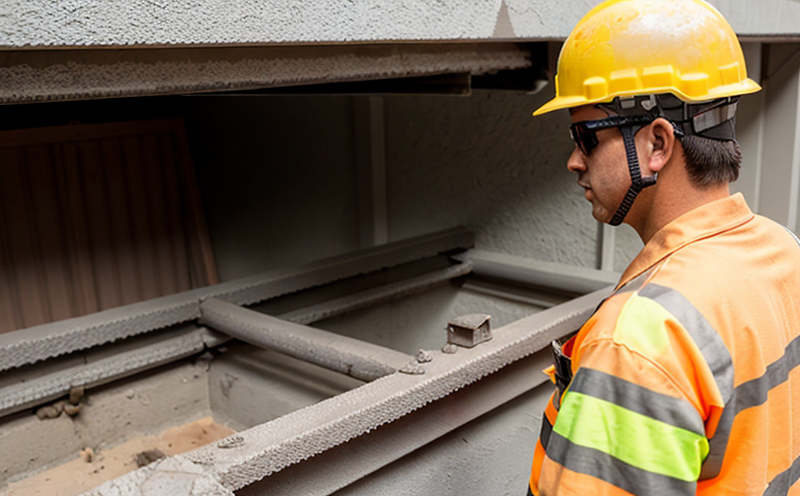Reinforcement bar inspection
In the construction and building sector, reinforcement bars are critical components that ensure structural integrity. These steel bars provide tensile strength to concrete structures, enhancing their durability and safety under various loading conditions. Proper inspection of reinforcement bars is essential for ensuring compliance with international standards such as ISO 25018 and ASTM C-773. This service ensures that the quality, dimensions, and material properties of reinforcement bars meet specified requirements.
The inspection process involves several key steps. First, the raw materials must be checked for purity and consistency with the specified grade. Next, the production process is monitored to ensure adherence to manufacturing standards. Upon completion, the finished products undergo rigorous testing to confirm their mechanical properties, such as tensile strength and yield point.
During inspection, several parameters are measured using specialized equipment. For instance, micrometers or calipers are used to check the diameter of the bars. Ultrasonic testing is also employed to inspect for internal defects without damaging the structure. In addition, hardness tests may be conducted using a Rockwell hardness tester.
The acceptance criteria for reinforcement bars vary based on their intended use and location within the structure. For example, structural members in earthquake-prone areas require higher tensile strengths compared to those in less active regions. Compliance with local building codes is crucial for ensuring that inspections meet regulatory requirements.
Failure to perform thorough inspections can lead to compromised structures, which may result in safety hazards and costly repairs. Regular audits of inspection practices help maintain high standards across projects. By leveraging advanced technologies like digital imaging and automated testing systems, laboratories can significantly enhance the accuracy and efficiency of reinforcement bar inspections.
Why It Matters
The importance of proper reinforcement bar inspection cannot be overstated. These bars form the backbone of many construction projects, playing a vital role in ensuring that buildings are safe and resilient against various environmental conditions. When inspected correctly, these elements contribute to long-lasting structures that withstand time-tested durability tests.
Ensures compliance with international standards like ISO 25018 and ASTM C-773
Aids in the identification of defective materials early in the production process
The consequences of poor quality reinforcement bars can be severe. Structural failures due to substandard materials could result in significant financial losses, reputational damage for constructors, and potentially life-threatening situations for occupants.
By prioritizing thorough inspections, stakeholders benefit from enhanced safety measures, reduced maintenance costs, and improved overall structural performance. Investing in reliable inspection services not only meets regulatory obligations but also fosters trust among clients and partners.
Quality and Reliability Assurance
Quality assurance (QA) is paramount when it comes to reinforcement bar inspections. Ensuring consistent quality across all aspects of the inspection process helps maintain reliability in construction projects. Here are some key QA measures that should be implemented:
Regular calibration of testing equipment to guarantee accurate readings
Training and certification of inspectors to ensure they meet industry standards
Inclusion of third-party audits to verify inspection results
The use of advanced technologies such as automated data capture systems further enhances QA efforts by reducing human error. By integrating these tools into the inspection process, laboratories can provide more precise and consistent results.
Reliability assurance is equally important in this context. To achieve reliable outcomes, it's essential to follow standardized procedures throughout every step of the inspection process. This includes using calibrated instruments, adhering strictly to test methods outlined in relevant standards, and maintaining detailed records of all inspections conducted.
By implementing these QA practices, laboratories can build confidence among clients by demonstrating their commitment to producing accurate and dependable results. This approach not only enhances project success but also supports sustainable development goals by promoting the use of high-quality materials.
Customer Impact and Satisfaction
The impact of reliable reinforcement bar inspections extends beyond just the construction site; it significantly affects customer satisfaction and trust in the industry. Here's how this service can positively influence customers:
Ensures compliance with regulatory requirements, thereby reducing legal risks for clients
Improves safety standards, enhancing confidence among end-users of buildings
Facilitates smoother project completion by identifying issues early in the production process
A satisfied customer base translates into repeat business and positive referrals. When clients see that their projects are being handled with care and precision, they feel reassured about the overall quality of work delivered.
Moreover, reliable inspection services help maintain a good reputation for both suppliers and contractors involved in construction projects. This reputation is built on the foundation of trustworthiness and reliability, which are crucial elements in any successful business relationship.
In summary, reinforcement bar inspections play an integral role in shaping customer satisfaction and fostering long-term partnerships within the industry. By focusing on quality assurance and reliability assurance, laboratories can contribute significantly to creating successful construction projects that stand the test of time.





